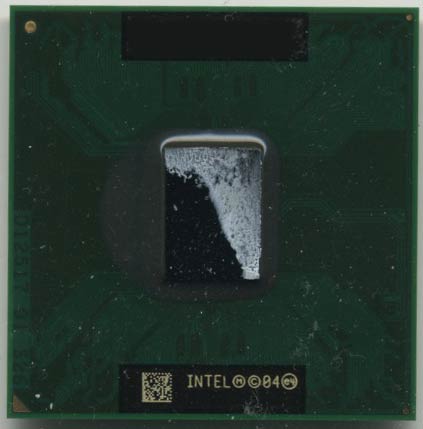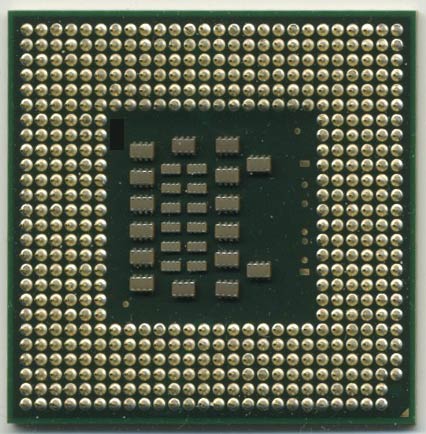Intel Yonah Performance Preview - Part I: The Exclusive First Look at Yonah
by Anand Lal Shimpi on November 30, 2005 2:50 AM EST- Posted in
- CPUs
Intel, oh Intel, how uninteresting your processors have been to us for so long now. Where have the days of the Northwood gone? Prescott brought us a minor bump in clock speed, minor increases in performance, and more importantly - major increases in power bills. But if any company can go down the wrong path for five years and still come out on top, it’s Intel. So starting next year, we’ll start seeing a new Intel. A more power conscious Intel and to kick it all off will be Intel’s first Earth-friendly dual core processor: Yonah.
As the successor to the current Pentium M (Dothan) and the predecessor to next year’s Conroe, Merom and Woodcrest cores, Yonah is a very important chip. As a mobile processor Yonah will bring dual core to thin and light notebooks, basically anywhere you’d find a Pentium M, you’ll now be able to find two Pentium Ms. The implications for mobile performance are huge, as multitasking on notebooks has rarely been all that great of an experience. At the same time, Yonah is so much more than just a dual core mobile processor - it’s a predictor of the performance of Intel’s next-generation desktop micro-architecture. Sure, it won’t have all of the architectural bells and whistles that we’ll see when Conroe debuts at the end of next year, but it’ll have many and that makes it a reference point.
The problem with the Pentium M architecture has been that although it’s traditionally done well at office tasks and obviously in the power consumption department, it has lagged behind the Pentium 4 and Athlon 64 when it comes to FP intensive applications such as video encoding, and to a lesser degree, 3D gaming. With Yonah, Intel has promised to address those performance issues, and even more so with their next-generation micro-architecture later next year. But we tend to want to see things for ourselves, and Yonah will at least give us an indication of how things have improved since Dothan, and whether or not Intel is on the right track to replacing the Pentium 4.
By now we’ve hopefully stressed the importance of Yonah, and there’s just one more detail to mention - we have one.
The Platform - Yet Another Socket
While the launch of Yonah still won’t be until January of next year, we’ve had a chip for the past month, unfortunately, we haven’t had a motherboard to stick it in. We finally got one two days ago, which is why you’re seeing this article now, instead of more pictures of our Yonah posing alongside the Xbox 360. The problem is that Intel seems to have changed sockets once more, meaning that Yonah is not backwards compatible with the original Pentium M socket.

If you’ll remember back to the introduction of the Pentium M, Intel introduced a brand new socket for the processor: Socket-479. Back then, the desktop Pentium 4 still used the pin-based Socket-478, so the different pin-out was a bit of a pain to deal with as we all wanted to be able to stick Pentium Ms in our Pentium 4 motherboards.

The Yonah socket is still a 479-pin interface, however the pin-out has been changed once more, and of course Yonah won’t even physically fit into any current Pentium M motherboards. Instead, you’ll need a brand new motherboard with a brand new chipset. So if you invested in any of the handful of desktop Pentium M motherboards that were released over the past year, you’re unfortunately out of luck.

Yonah (left) vs. Dothan (right) - Note the different pin-out
What’s this about a new chipset? Well, it’s not exactly a new chipset, rather it’s Intel’s mobile 945 chipset - the mobile version of the desktop chipset we’ve had for quite some time now. The platform we’re testing on in particular uses Intel’s 945G chipset, with integrated graphics, but of course we aren’t too interested in integrated graphics performance so we’ll be using the PCIe x16 slot on the board.
While we can’t tell you who makes the motherboard we’re testing with, the important thing to note is that it is a desktop motherboard made specifically for Yonah. It’s got a single PCIe x16 slot, meaning you don’t have to rely on integrated graphics, and all of the bells and whistles you’d expect from a desktop motherboard; this could very well be the heart of your next system.
We’ve been hearing that Pentium M based desktops will become a lot more common next year, and this motherboard is definitely an indication of that.










135 Comments
View All Comments
bhtooefr - Wednesday, November 30, 2005 - link
Also, isn't there a way to disable the second core in BIOS?I think it's definitely possible to make your dual-core chip into a single-core for testing.
Slaimus - Wednesday, November 30, 2005 - link
No, since it is a CPU with double execution units, rather than 2 CPUs linked together.fitten - Wednesday, November 30, 2005 - link
I've not seen that stated anywhere. What I've seen is that there are two cores, two independent L1 caches, and a shared L2 cache.Anemone - Wednesday, November 30, 2005 - link
The reason it was compared against the X2 is simply because that is where the next gen Turion "may" land in performance. Power consumption in this test is nice, but not really relevant to the new Turion, nor is it relevant to the mobile arena where AMD with integrated controller does well against P-M plus external controller consumption (well though Intel is better so far).I had a feeling things were going to turn out this way. That cache on the P-M is really what makes it such a nicely performing chip. Weakening that was really the telling test in all this. It's nice that you put that test first. The dual core Turion is going to be very close in release timing to Yonah, and quite a few samples of the chip are already out there, but I'd bet AMD is keeping its cards close, as it has less of a need to prove a point.
However, from a mobile perspective AMD's use of Via and ATI chipsets really will be the telling factor, and will impact the "you get it all" bundle of a notebook. Where, after over a year, is Nvidia and a pci-e mobile chipset for AMD? Turion is almost out the door and they haven't even spoken up yet. That's probably because they won't be there when Turion releases. If Nvidia had no chipset on the desktop, the competition would be starkly different right now, and a good many folks know this to be true. So I'm expecting the dual core Turion to do incredibly well. 64 bit isn't an end all be all, but it will be a wonderful perk when Vista comes, and Vista will be here sooner than previously expected. Power consumption "may" favor Yonah, however Intel is doing what they always do, when a chip performs so-so, they push up the clockspeed. When they find out what Turion has on the table, they'll put out the EE version of Yonah to try to match it. THAT I bet, won't be so power friendly.
Intel is improving on Yonah with Conroe. But remember that the low latency L2 is what gave the Dothan its ability to stand in the A64 arena. That got lowered and we see the results. Now imagine what will happen when they "gently" increase the pipeline of Conroe vs P-M/Yonah. It'll drop a bit again. Against that you'll have architecture improvements and higher clockspeed (Conroe is expected to clock higher). That might end up making Conroe only "slightly" better than Yonah. That is why the marketing of th two can overlap, probably.
So IF (and it's not promising) Nvidia gets the NF4 into a mobile format and gets builders to use it on the new Turion dual cores, we might see some interesting things from the AMD side. If not, they stay as now, a niche market only. ATI chipsets aren't going to change that, much as they have not done much to the desktop side of things.
IF Yonah clocks at 2.6ghz you may see some competitive desktop systems to A64 X2's. It will rule the mobile roost unless the above happens for AMD. Conroe had better make some dramatic improvements to even Yonah's ability, though I'm doubtful, or putting both Yonah and Conroe on the desktop will simply hand even more of the market to AMD. On the mobile front, again unless the above happens for AMD/Nvidia on a mobile chipset, you will watch Yonah/Conroe rule the mobile roost.
:)
Griswold - Wednesday, November 30, 2005 - link
Intel just now managed to close the gap between them and AMD as far as dual core is concerned. I dont care if one is a mobile part and the other is not, mobile computing is of no interest to me and even less dual core mobiles. But it gives a good idea of what to expect.The numbers are there. Yonah isnt groundbreaking besides the fact that it is a dual core - and the desktop versions probably wont be either. Wow, thats late...
nserra - Wednesday, November 30, 2005 - link
TG Daily: What is your reason for not including support for 64-bit technology in Yonah? Why is it going to be supported only in Meron?Perlmutter: Like everything in technology or life, it is all a matter of timing. Integrating unneeded features into a processor means a waste of power consumption. Our assumption was, and still is, that 64-bit extensions are not the most important thing required from a processor, not even in the beginning of 2006. We believe this will change with Windows Vista, when applications start migrating to 64-bit, and we want to be ready then, and not a minute earlier.
Furen - Wednesday, November 30, 2005 - link
64-bit extensions = more transistors, which means higher power consumption.Donegrim - Wednesday, November 30, 2005 - link
If this is cheaper than the X2 3800, and overclocks really well on the desktop (say, 2.7-3ghz or so), then I could see myself being tempted by it. As long as the 'secret' motherboard isn't as ridiculously overpriced as current dothan desktops.Griswold - Wednesday, November 30, 2005 - link
WHat makes you think that thing will go to 2.7-3ghz? *laff*Donegrim - Wednesday, November 30, 2005 - link
Well the x2 3800 that consumes much more power (therefore is hotter) consistently goes to at least 2.5ghz, so I don't think it's unrealistic for a lower power chip to go further. Plus the FSB is nice and low, which makes for a good start with the overclocking.